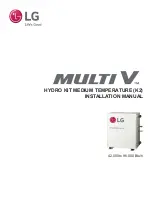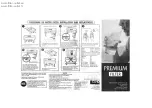
12
CSS 12
Section 3
Pool Preparation
Establishing Water Balance
While the
CSS 12 systems are designed to reduce the amount of chemical care —
it does not eliminate the need for water balance!
Understanding how the unit fits into overall pool care is extremely important. Before starting your new sanitation system, you will need to take a water sample
to your local pool dealer for a full analysis. There are two stages to clean, clear, safe water.
1.
Backyard Testing:
Your pool water should be checked one to two times per week for pH, Chlorine, and salinity (salt).
a.
pH should be between 7.2 and 7.6. Any readings outside of this range needs to be corrected immediately.
b.
Free chlorine should be between .5 and 1.5 ppm (parts per million). Chlorine levels that are too high may require an output adjustment on
your system. Chlorine levels that are too low may require salt addition or adjustment of the system.
c.
Salinity should be between 2500 ppm and 3000 ppm. Levels that are too low will result in inadequate chlorine production. Levels that are
too high, (>3,300 ppm), will result in CSS system shutting down.
Professional Testing:
A water sample needs to be brought to your Professional Pool dealer once a month to have the overall water balance checked.
a.
In addition to verifying your readings, the dealer will also test for Alkalinity, Calcium, Stabilizer, and the presence of any unwanted minerals
like iron and copper. Electronic salinity testing is critical to CSS system performance.
∆
WARNING:
Failing to properly balance your water may result in damage to the CSS 12 unit as well as the pool surface and equipment. Bathers
will experience discomfort. Note: This and all related product warranties do not cover failure or damage caused by improper poor water balance.
3.2
Preparing Your Pool
Test and balance the pool water. Pool water must be at the proper salinity level, and chemically balanced before operating the CSS 12. Refer to Table on
page 6 for required levels. Pool should be balanced in this order:
3.1
Water Testing
1)BalancepHto7.2-7.6
2)ShockpoolwithChlorineto20PPM
3)Brushpool
4)Vacuumandbackflushtodump
5)Addrequiredsalt
6)Wait4hoursforpooltoequalize
7)BalancepH
8)Runcirculation/CSSsystemfor48hoursandcheckchemicallevels
9)CheckFilter
3.3
Adding Salt
Test the salt level of your pool before calculating the salt requirement, particularly if a salt chlorine generator has been used, or sodium chloride has been
previously added to the pool water. It is best to use an electronic measuring device rather than test strips for accurate measurement. If pool has excessive
salt or salt is not properly mixed, system may eventually shut down and must be re-started by turning power switch off and on again. Salt should be
thoroughly dissolved before turning system on. When adding salt after pool has had initial bank, it is best to dissolve salt prior to adding it to the pool.
Salt should be added per the following formula to meet concentration requirements, providing the pool water has not already had any salt added to it.
Pool size in gallons can be determined from the following formulas:
• Rectangular – Length x Width x Average Depth x 7.5 (for gallons) or x 1000 for liters.
• Round – Diameter x Diameter x Average Depth x 5.9 (for gallons) or x 785 for liters.
• Oval – Length x Width x Average Depth x 6.7 (for gallons) or x 893 for liters.
21 pounds of salt for every 1,000 gallons of pool water
3.0
Air Flow Setup
Your CSS 12 System comes supplied with a 0-10 SCFH air flow meter. This meter is used to properly setup the CSS system to guarantee sufficient air and
water flow through the bypass. To test your system for air flow, verify CSS 12 is turned off. Turn pool pump on. Disconnect 1/4” hose from Injector port # 1.
Injector is located on top of chlorine cell on the right side of the control unit. Connect the 1/4” hose, on the air flow meter, to injector port # 1. Holding meter
in a vertical position, you should get a reading between 2 SCFH and 10 SCFH. If flow is lower then 2 SCFH, a ball valve will need to be installed in the
plumbing as shown in alternative installation methods on page 10. This may require moving bypass entrance and exit locations. If a ball valve is added to the
system, it will need to be adjusted to maintain the required air flow. This is done by first starting with the ball valve in the fully open position. With the air flow
meter attached to injector port # 1, slowly close ball valve until the meter reads 2 SCFH to 10 SCFH, (5 SCFH is the best air flow). Never turn the ball valve
more that half-way closed. The air flow should never be greater that 10 SCFH. Once air flow is set as required, remove 1/4” meter hose from injector and
reconnect 1/4” system hose to injector port # 1. System can be operated at this point but will not generate chlorine until proper amount of salt is added to the pool.




































